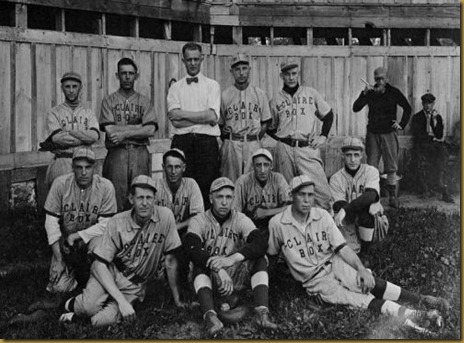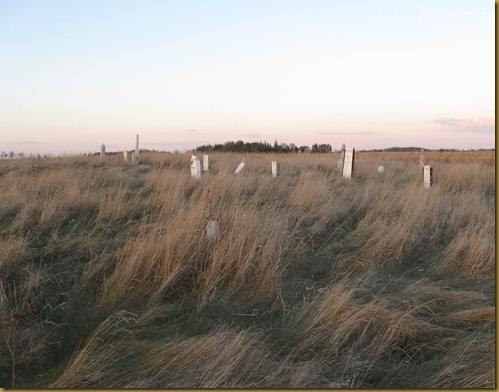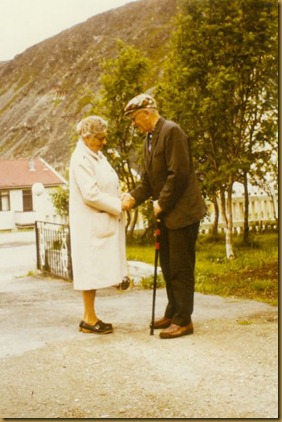
Monday, September 10, 2012
Armour Packing Company
Monday, September 3, 2012
I Lied to Read True Story Magazine
"I'm almost finished," I yelled back to her, as I turned a small piece of the corner of the page to mark my place, and stuffed the magazine quickly back in the linen closet. A needless flush later, and trying to look as nonchalant as possible, I exited the bathroom and hoped Grandma wasn't standing there with a spoon and that bottle of nasty green liquid.
I was reading her True Stories. She knew I was reading her True Stories. I knew *she* knew I was reading her True Stories. Such forbidden tales as "A Case of Cradle Robbing" or "My Runaway Wife" or "I Am the Other Woman" were about as close to excitement as it got in my small town life. And to a young girl on the cusp of being a teenager, this glimpse into mysterious and exciting adult lives was too much to resist.
Grandma and I apparently were not alone in our enjoyment of this magazine and the exotic lifestyles and stories it featured. According to Wikipedia, True Story came into existence in 1919, and in the next few years circulation soared, and the magazine lasted 92 years before the publisher finally pulled the plug.
One afternoon, to my dismay, the magazines were no longer in the linen closet in the bathroom. I did a thorough search (more than once), but Grandma apparently found a better place to store them, at least temporarily. Being unable to find their new hiding place was driving me crazy. They did at some point make their way back into the bathroom closet, and my extended bathroom breaks resumed. Did Grandma know I was reading her True Stories again? Of course. Couldn't hide anything from that woman. But she never did move them again.
Monday, August 27, 2012
Lies Grandma Told
I was recently looking at some photos of my brother, sister and I as kids, with Grandma Lill's cockatiel, Charlie, sitting on our shoulders. All of us had our heads cranked straight ahead, but were looking at him out of the corners of our eyes. I realized that all of our pictures with Charlie were like that - because Grandma always told us if we looked right at him from close range, he'd peck our eyes out. I don't know if that's true, or if she thought it was true, or if she didn't want to take a chance on it being true, but I'm still scared to look a bird in the eye at close range 40+ years later.
Are you happy, Grandma??
I started thinking about some of the things she told us as kids - "If you swear, rocks and dirt will come out of your mouth, but if you talk nicely, flowers and sweet things will come out of your mouth instead." I wondered briefly what rocks and dirt would taste like, but then decided that a flower in my mouth probably would not taste much better, so I went into the bathroom, locked the door, and crawled up to the mirror above the sink, and very cautiously said the first bad word I could come up with. Shortly thereafter, I started to wonder if Grandma was full of... well... baloney.
Being a woman small in stature, and having charge of the three of us all day while my mother worked and Grandpa was out at the farm, she needed an Equalizer - and I think she found one in her little white lies. For a long time after the "Rocks and Dirt" story, we talked nicely. When I discovered that her attic was filled with wonderful old things to play with (without permission) she told me the floor was bad in spots, and if I stepped in just the wrong spot, I'd fall in between the walls and even Grandpa would not be able to get me out. I never went up in the attic again without her.
She told me about her classmate at school, who squeezed a pimple on Friday and was dead of blood poisoning by Monday.
She told me the man across the street was a policeman, and if I left the yard without permission, he'd see it, and he *could* arrest me if he had a mind to. Not saying he would, but you never know. He doesn't like it when kids leave the yard without permission.
But she was right regarding a lot of things in life, and despite the occasional bamboozling, she taught me a lot. "Don't always trust whoever you're doing business with, they may not have your best interest at heart." "Never quit your job until you have another one lined up."
When someone is talking trash about you, "consider the source."
Don't brag up your boyfriend to your girlfriends.
And, "If you have leftovers, you know everyone at your table got enough to eat," followed quickly by "Grind up your leftovers and put them in the meatloaf."
Love ya lots, Grandma, and miss you every day.
Monday, August 20, 2012
The Original Party Animals
To be honest, I don't remember a lot of the details of our party. We likely watched Guy Lombardo on TV, and ate yummy munchies that Grandma Lill had prepared . Lill, who was behind the old brownie camera that took this picture, had a stash of little tiny hats with elastic bands to hold them on, and a box of various noisemakers - some you twirl, some you blow in, others you just shake. It was a fascinating collection, which we only saw once a year, and then, briefly. We donned our garb, and for about a minute - no more - we were allowed to make as much noise as we could with our noisemakers, and then they were collected, put back in the box, and hidden in places unknown until the next New Year's celebration.
I was nearly four years old in this picture, my brother just days away from turning two. We had an inter-generational party, with our grandparents and great-grandparents, and "warm fuzzies" like we'd never have again. We had one more year with both sets of grandparents, before my great grandfather, Will Knutz, developed stomach cancer. But on this particular year, we gathered, we loved, we celebrated, and we made memories.
Wednesday, August 15, 2012
The Short Life of the Unpopular Bonnie Posy
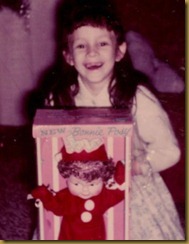
The year was 1965. Yes, that’s me, with my new Christmas present, Bonnie Posy. Despite the obviously pleased look on my little face, I have no recollection of ever owning that doll. Don’t remember playing with it. Don’t remember picking it up off the floor. Don’t remember what ever happened to it.
I’ve had a lot of luck learning about old toys through Google and eBay, most impressively through the Ugly Baby posts. I never thought I’d know so much about that doll. But for some reason, Bonnie Posy is proving to be a more difficult subject.
The only information I was able to find on this doll was through a couple of newspaper ads, circa 1964-65, one of which appears below:
The above advertisement was from the Milwaukee Journal, December 4, 1964, courtesy of Google News. While it vaguely resembles my doll, it’s obviously not the same; but the doll in the ad is the 1964 version, and mine made her appearance the following year – perhaps a newer model. At any rate, with Cootie games (remember those?) selling for ~$1.50, the $4.99 price tag on this doll would suggest that it was a much-coveted item on the wish list of little girls of that era.
So why don’t I remember this doll? The only other ad I found was for these dolls on “clearance” in 1967, so perhaps Bonnie Posy was a “flash in the pan.” Apparently mine was!
Tuesday, August 7, 2012
Dippity-DON'T!
I was a little kid with goofy hair. It was fine, but thick, and Grandma hated looking at it. To call it "unruly" would be an understatement. Most of the time, she let it slide, but one day, she decided to show me how nice it could look with a "little" work.
So she stuck my head in the sink, towel-dried my hair, and gathered up her "makeover kit" - a comb, a container of rollers, and, of course, her jar of that miraculous green goop, Dippity-do. That stuff still scares me to this day. After she got my hair combed out (anyone who had long, thick hair as a child knows the pain that combing entails) she would part off a section, slather it with a generous dip of Dippity-do, roll it up, and proceed to the next piece of hair.
To stop my incessant complaining ("that stuff stinks," "I want to go watch TV," "Stop it, Grandma!" and, of course, "OW!!") she let me play with a few of her rollers - we called them Spaceship Rollers, but the real name for them is Spoolies, probably for more obvious reasons. These were soft, pliable, rubbery curlers. A section of hair would be rolled in the middle, and then each end would flip back toward the middle, creating a spaceship sort of shape, and securing the hair.
It seemed to take forever for her to finish rolling my hair - actually, it probably did take forever. We used every one of her Spoolies in all that thick hair, and she had a lot of them. Between all those curlers and Dippity-do, the sheer weight of my head hurt my neck to the point of having to lay down, but resting my head on anything hurt worse. One valuable lesson I learned that day (besides RUN when Grandma gets the curlers out) was to not stress her out while she was rolling my hair, or the curlers would be tight - really tight!
Hours later, she finally took all those miserable little spaceships out of my hair. I was left with a head FULL of curls so tight and crispy that neither brush nor comb would get through them, and hair bigger than any 1970s rock star ever had! Grandma looked a little shocked - I started to bawl - and when my mother came to pick me up, I hid on the floor of the back seat all the way home, and immediately stuck my head back in the sink to rectify this terrible situation.
On a positive note, Grandma Lill never tried to fix my hair again. Instead, she turned her attention to my little sister, who was not nearly as fast as I was after that.
Thursday, August 2, 2012
Who Is That??
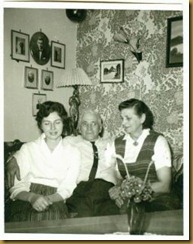
I recently discovered this old photo of my grandfather, Adolph Hammer, from one of his trips back to Norway. I did not recognize anyone else, and wondered if these ladies were his relatives, or those of his wife, Lise Klungseth Hammer. But before I had that thought, my eyes immediately made their way to the photos on the wall in the background. I have found more treasures in the backgrounds of photos than anywhere else.
Thanks to high-resolution scanning, I was able to get a much better look at the faces in the back.
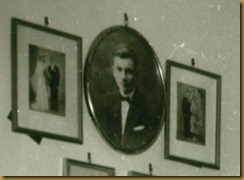
To the left is the top tier of photos – the fellow in the oval frame resembles Lise’s brothers - thankfully there is a strong family resemblance between many of those siblings. Being the largest photo and placed at the top, it could be probably safely assumed that the man in the photo is the head of this household. Perhaps it is his wedding photo and an anniversary photo flanking the larger photo.

The second tier of photos looked very familiar – these are Lise’s parents, Bergitte and Edvard Klungseth. I have copies of these particular photos in my files, positively identified as the Klungseths, leading credence to the theory that this is the home of one of their sons. The photos of Bergitte and Edvard were taken ~1920.
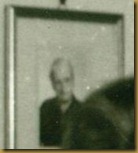
The picture at the bottom is somewhat of a mystery. I don’t recognize the face, and am not certain if this is a man or a woman. The placement of the other photos with the more current generation at the top, and the parents in the center, might suggest that perhaps this is another generation further back, perhaps a parent of either Edvard or Bergitte. However, the style of the photo and the apparent age of the subject doesn’t seem to support that idea.
I did go back through my files to see what photos of the Klungseth sons I have; I have pictures of all but Kristian and Torleif. Torleif died the age of 24; and while the man in the oval frame could be about that age, the positioning of the wedding portrait next to it suggests that it is of the same man; Torleif did not marry.
Perhaps the women seated with my grandfather are Kristian’s wife and daughter. Perhaps not. But this seems to be the most likely conclusion to the mystery, thanks to the clues in the background. Now – who is that person in the bottom tier of photos??
Wednesday, June 27, 2012
Wednesday, June 20, 2012
Wednesday, June 13, 2012
Wednesday, June 6, 2012
Wednesday, May 30, 2012
Wednesday, May 23, 2012
Wednesday, May 9, 2012
Friday, May 4, 2012
Wednesday, April 25, 2012
Wednesday, April 18, 2012
Wednesday, April 11, 2012
Friday, April 6, 2012
Burials in Norway
I was unaware of their website, at http://www.disnorge.no/gravminner/global1.php, until the kind folks at Ancestry.com notified me that they may have burial information for my great-great grandmother, Olea Ganesvik, pictured at left. I clicked the link, and for the next several hours was engrossed in searching for all of my Norwegian ancestors. I was able to find burial information, among other things, for many of them.
The database, something on the order of an early Find-a-grave, exists to aid genealogists in locating the burial sites of their ancestors, and has received grants from the Norwegian Arts Council to aid in their work. The bad news is, the site is in Norwegian. The good news is, you can get an English search page at http://www.disnorge.no/gravminner/index.php?language=engelsk The bad news is, other pages on the site don't offer an English option. But the good news is, if you use Google Chrome, the browser will offer to translate for you. The bad news is, nothing is infallible, including Google's translation. "Olea Ganesvik" translated to "Olea Gane Deceit", so proceed with some caution and perhaps consider keeping the Norwegian version open in a separate browser tab for easy comparison.
The information available on the site may differ from one ancestor to another, but typically, name, date of birth, date of death, date of burial, cemetery name, and location within the cemetery are typically given. I would assume the database is far from complete.
Another piece of good news - the database does allow for corrections to be made. In the table of search results, the right-hand column contains an icon that when clicked, whisks you away to another page containing the same data, but with columns for corrections/additions, and also a place to add comments, along with your name and email address. Whether or not the comments and contact information will be added to the website is anyone's guess, but it wouldn't hurt to try, and you never know - it could result in making contact with a distant cousin. In addition, source information can be found on the correction page. The primary source of information for my ancestors was the website of The Norwegian Church at http://www.kirken.namdal.no, where photos of some of the churches and graveyards could be seen. I was very glad to see photographs of Steine Church and cemetery, where my paternal great-grandparents are buried, a beautiful place that I will probably never be able to visit in person.
Something initially confusing was the date format - for instance, a day of death is written as "0805" which is 08 May, NOT 05 Aug. One other thing that I eventually figured out is that the search box will take more information that simply names. For common names, adding a birth or death year, if known, might save you from looking through page after page of results. And, since only 10 results can be viewed at a time, if you have hundreds to go through, this will save you many, many mouse clicks.
All in all, I was delighted to find this website, and very grateful for the information gleaned from it. Check it out when you have a few hours!
Wednesday, April 4, 2012
Wednesday, March 28, 2012
Wednesday, March 21, 2012
Thursday, March 15, 2012
A Perfect Ending
His obituary is standard fare - 84 years old, prominent farmer, moved from his home in Stark county, Illinois to Madison county, Iowa, married Nannie, had children, etc. But the best part of the story isn't found in the obituary.
It was Christmas Day, 1954. John's niece, Zella and her family were on their way to her father's home for Christmas. They stopped to deliver Christmas greetings to John and Nannie. John and Nannie were not planning an early Christmas meal with their own family but were preparing to have a quiet lunch at home instead. They were both feeling well and in good health. After a short visit, Zella and her family continued on their way.
Later that afternoon while the family was opening presents, Zella took a phone call. After all the presents had been opened and "thank yous" given, she told the family that after lunch, Uncle John had laid down to take a nap and had passed away quietly in his sleep.
I can't think of a better ending to life - a nice visit with loved ones, followed by a quiet meal at home with my beloved spouse, and then simply relaxing and closing my eyes, all with a lovely white, snowy, glittery and joyous Christmas Day backdrop. A gentle drift into eternity. Rest in peace, Uncle John Graves, and thank you for a wonderful story.
Wednesday, March 14, 2012
Wednesday, March 7, 2012
Wednesday, February 29, 2012
Wednesday, February 22, 2012
Tuesday, February 21, 2012
Where You've Been - or Where They've Been
I ran across this fun little site that will show you where you've been (or haven't been, in my case). I thought it would be fun to make a map to add to my genealogy websites for each branch of the family. For instance, my direct-line Graves ancestors settled in the areas marked on the map in red -
Wednesday, February 15, 2012
Wednesday, February 8, 2012
Wednesday, February 1, 2012
Monday, January 9, 2012
Military Monday–Hoping for a Homecoming, Part 2
In one of his very informative emails, David sent the link to the Defense Prisoner of War * Missing Personnel Office’s website. This office is actively working to identify remains, and it’s never too late, as this very recent press release regarding Staff Sgt. John J. Bono demonstrates. Staff Sgt. Bono was on a plane that crashed on September 13, 1944 in Germany. It took a very, very long time, but this soldier has finally come home.
One of the methods used for identifying remains involves mitochondrial DNA. Unlike Y-DNA used for genealogical purposes, mitochrondria DNA (mtDNA) cannot prove relationship to any high degree, but it can exclude relationship, or can provide supporting evidence of a relationship. Furthermore, rather than requiring a sample from the direct-line males in the family, mitochondrial DNA may be supplied from other near relatives. In the case of an unaccounted-for male soldier, either a brother, a sister, or the sister’s descendants to the third generation may supply DNA for testing.
The Central Identification Laboratory does the work of putting together the evidence with the goal of making an identification. Using data surrounding the recovery of the remains, race, age, height, medical and dental records, fingerprints, and DNA, sometimes a presumptive identification can be made.
Without delay, I contacted the Central Identification Laboratory (CIL), and settled down for what I was expecting to be a long wait. Within the week, I received a phone call from an agent at the CIL requesting more information, and explaining the process to me. He sent, by Federal Express, two mtDNA collection kits, one for myself, and one for my mother, direct descendants of Ray’s sister Lillian. The kits consisted of swabs that we used on the insides of our cheeks to collect cells. We packaged these swabs for return to the lab. In addition, we were asked if we had envelopes from any of Ray’s letters home; the process of licking the envelopes to seal them would be his contribution to the process. We had two, which we sent. We were assured that they would be returned. The process was very quick, and very simple, and return Fed-Ex fees were paid by the laboratory.
And now, we wait. We understand that this process will not be a quick one, and no results can be guaranteed, but we’re grateful for the opportunity to at least try, thanks to David. I’m hoping that 2012 will be the year Raymond Christensen finally comes home.
Wednesday, January 4, 2012
Monday, January 2, 2012
Military Monday–Hoping for a Homecoming, Part I
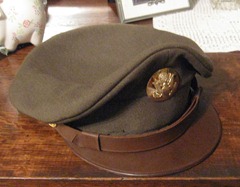 My correspondent, David, who is a collector of military items and a veteran himself, had read my blog post regarding my uncle Raymond, who, along with his pilot Joseph Leonard, were lost when their plane went crashing down into the Tyrrhenian Sea near Montecristo late on the night of May 13, 1944. David had found a soldier’s cap with the name Lt. Joseph E. Leonard on it, and was doing some internet research to learn more about this fallen hero. We exchanged information – I had information on Ray, including a Missing Air Crew Report, and he had expertise on all things military, and so our conversations began.
My correspondent, David, who is a collector of military items and a veteran himself, had read my blog post regarding my uncle Raymond, who, along with his pilot Joseph Leonard, were lost when their plane went crashing down into the Tyrrhenian Sea near Montecristo late on the night of May 13, 1944. David had found a soldier’s cap with the name Lt. Joseph E. Leonard on it, and was doing some internet research to learn more about this fallen hero. We exchanged information – I had information on Ray, including a Missing Air Crew Report, and he had expertise on all things military, and so our conversations began.Since our family was notified of Raymond’s status back in 1944, little has changed. The last we heard, the crew of the Bristol Beaufighter KW 161 was missing and unaccounted for. All that remained at the site of the wreckage was “much debris, an oil slick, and two life rafts.” End of story.
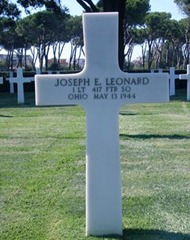
It was during these exchanges when David told me that Lt. Joseph Leonard was buried at the Sicily Rome American Cemetery in Nettuno, Italy: Plot H, Row 9, Grave 40. What? Raymond Christensen was not buried there, nor was he listed among any of the other identified soldiers in overseas cemeteries. Both men went down in the same location at the same time. One was recovered. One was not?
David’s words eventually sunk in: He was telling me there may be a possibility that Raymond’s remains were not lost, but unidentified. Dog tags, David explained to me, were typically the only means of identifying remains, and if Raymond had lost his dog tags in the events of that night, he may have been recovered but not identified.
More to come.
Saturday, December 31, 2011
2011–The Year in Review
 As I sit here pondering the end of another year, sometimes it’s the hard times that seem to rise to the surface of my consciousness more quickly than anything else. The low point of the year was losing a good friend and genealogy partner, John Melton, quite unexpectedly. I had the blessing of working with John on various projects off and on for the last ten years, and will miss his unending energy and his sense of humor. Rest in peace, friend.
As I sit here pondering the end of another year, sometimes it’s the hard times that seem to rise to the surface of my consciousness more quickly than anything else. The low point of the year was losing a good friend and genealogy partner, John Melton, quite unexpectedly. I had the blessing of working with John on various projects off and on for the last ten years, and will miss his unending energy and his sense of humor. Rest in peace, friend.
I also had to say goodbye to one of those rare places on earth that, when you look at it, fills you with abundant history and happy memories. Voorhees Hall, the main building of long-defunct Huron College, was torn down after 100+ years of service. I loved the beautiful architecture of every part of it, and enjoyed my years there, especially sitting on the north steps smoking a cigarette between classes with all of the other slaves to the habit, and met some wonderful people while doing so. It will be hard to drive past that site and not see it there.
On a more positive note -
I started what hopefully will be the most fruitful thing I’ve ever done, at least in genealogy terms. I’ve blogged about my great-uncle, Flight Officer Raymond Christensen, whose Beaufighter plunged into the sea near Corsica while tangling with the Nazis. I’ll be blogging more about this, but to make a long story short, through one of those Genealogy Angels, I’ve discovered that the body of Ray’s pilot, Joseph Leonard, HAD been recovered and identified. This certainly increases the chances that Ray’s body was recovered as well, perhaps just not identified. Our family has begun the process of looking for a match, aided by mitochonrial DNA. Perhaps 2012 will be the year we can bring Ray home to rest.
I’ve been able to scale of couple of other genealogy mountains in 2011 as well. After years of trying to positively identify the parents of Charlotte DeBolt, it looks likely that her father was Patrick Burnside(s) of Ohio. A book of will abstracts was published years ago listed among Patrick’s heirs a Charlotte DeBolt and her husband William DeBolt. Hmmm… my Charlotte’s husband was Daniel DeBolt. I got the entire probate packet and later in the probate, Charlotte is again mentioned with her correct husband, Daniel. The initial mention of William was perhaps an error, as her brother, another heir, was also named William and listed next after Charlotte. I’d like to find at least one more solid indication of a relationship between Charlotte and Patrick Burnside before I’m ready to call this mystery “solved”, but this is a wonderful piece of evidence.
In addition to continuing with my ProGen Study Group, I also took on another county site for Genealogy Trails – Peoria County, Illinois. This is a special county for me, as my ancestors hail from there, and I used to have a Peoria county website that operated independently, but after nine years, had to take it off-line. I’m glad to be “back in the saddle” and involved with Peoria County’s rich history and pioneer families, and grateful to the site’s former host for all of her hard work in making this a fantastic resource for Illinois researchers. I look forward to adding a ton of data to the site in 2012. In addition to the Peoria County site, I’m still hosting the South Dakota state site, as well as Beadle and Hand County sites.
I’m looking forward to an exciting, even exhilarating, 2012, and wish the same for all of you!
Saturday, December 3, 2011
Scrapbook Saturday–A Working Gal
The National Youth Association’s representative recommended Louise for a job after her high school graduation in 1937. Her first assignment was bookwork on easements for Highway 14 through Hand County. Later, she did bookwork for the WPA Road projects in the county for 20 cents an hour. Her bookkeeping methods became perfected over the years, and used as a model for other departments. A copy of a letter from another Highway Department bookkeeper, written in 1963, was used on this page. It reads in part as follows:
“I am the Hwy. Bkpr. for Potter County, and the State Auditing Department has criticized me to a crisp for being to [sic] slow in getting out my yearly report.
“They recommend your books and your system as the peak of perfection, and suggested that I ask you for an appointment and do it as you do it.
“I have worked a great deal and I understand that time is a precious commodity for the gal that works, if you are able to find time to take me on for a bookwork discussion, I will be most glad to reimburse you for your kindness.”
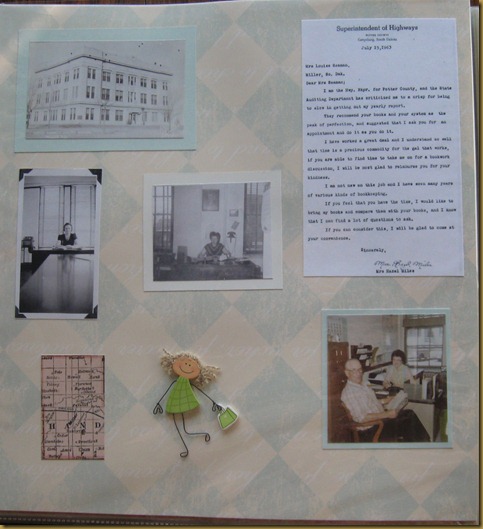
In 1977, South Dakota Governor Dick Kneip proclaimed “Louise Ulmer Day” in recognition of her numerous contributions over the years. Hand County was always a very important part of her life.
Saturday, November 26, 2011
Scrapbook Saturday–Photo Pedigree
Louise starts – followed by her parents, Casper J. Kluthe and Jennie Schlechter. Casper’s parents were Casper Kluthe and Maria Katherina “Katie” Kleine, both German immigrants. Jennie’s parents, also German immigrants, were Conrad Schlechter and Johanna “Jennie” Grewe.
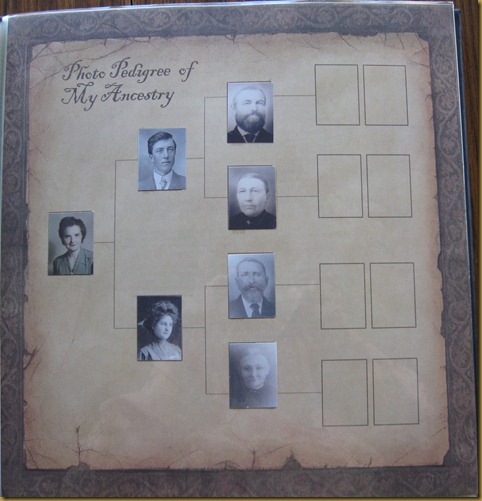
Saturday, November 19, 2011
Scrapbook Saturday - "House of Used-To-Be"

Sunday, October 23, 2011
Genealogy, Family History, and Censorship
As a volunteer for Genealogy Trails, and as a person trying to be a “good neighbor” in the genealogy world, I spend a fair amount of time transcribing public domain materials that might be of help to someone else researching their family history. While traveling, I oftentimes make unexpected stops at small rural cemeteries and snap a few headstone shots for Find-a-grave. I’ve been helped immensely by others doing the same thing, and want to pay back as much as I can. One never knows when some little nugget they’ve put online might be just the thing to put a chip in someone else’s brick wall.
I started a blog, Sharing Genealogy, for making available oddball items I run across, or find sitting on my office bookshelves. Awhile back, I found a book on the history of St. Paul, Minnesota, which I picked up at a library book sale. I personally have no ties to St. Paul, but someone, somewhere does, and thumbing through it, I found some interesting stories, and some old photos. So I decided to start scanning and transcribing it – all 222 pages. All was going well, until September 30, when Chapter XIII was posted – “Chippewas and Sioux.” The next thing you know, I have an ugly, anonymous comment posted questioning my motives and calling this post “bigoted and ethocentric white man crap.”
I answered as politely as I could, but that wasn’t the end of it. Thanks to comment moderation, no more hateful venom is online. But it does bring up the point of censorship – is it right? Should we, as sharers of the past, be held responsible for editing another’s work? If yes, whose standards do we use? Our own? Or the standards of the most sensitive persons that might read our blogs? If the latter, will we offend someone who resents our editing? Is there a “happy medium”, and if so, how do we define it? Only one thing is clear – this is muddy water.
Sunday, October 9, 2011
Voorhees Hall–There and Gone

I’m not sure of the exact date on the above postcard of Huron College (Huron, South Dakota), but would guess it to be ~1910. I grew up looking at this wonderful old building, Voorhees Hall, and during a few times in my childhood, had occasion to enter this grand structure, always captivated by the beautiful architecture. Eventually, I went to school there myself. Within those old walls you could almost feel the history, and going up to the huge lecture room on the third floor you could feel the presence of one hundred years’ worth of scholars, filling their minds with worldly knowledge.
So this was a particularly sad time for me when a friend sent the photo below. Voorhees Hall is no more – razed to make way for a swimming pool.
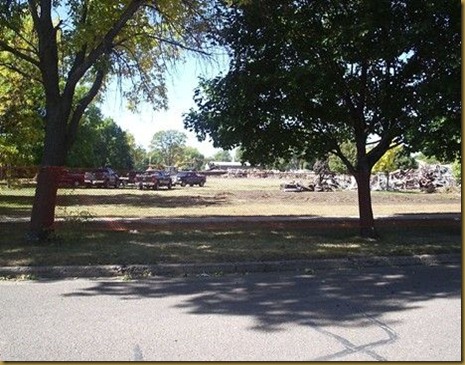
It’s going to take a very long time before seeing this sight doesn’t hurt…
Photo courtesy of Michael Bonnes
Wednesday, October 5, 2011
Tuesday, October 4, 2011
She Banged the Banker
A newspaper article too good not to share. If only they wrote articles like this these days…
This article appears to be from the Peoria Star, Peoria, Illinois, and is in a scrapbook created by the Princeville Heritage Museum, Princeville, Illinois.
Susannah was the younger sister of my ancestress Rebecca DeBolt Lair, and Peter Auten was a local banker referred to by Rebecca in her will as “my good friend.”
SHE BANGED THE BANKER
Old Maid of 85 Years Vigorously Demands Her Rights
Sunday, May 24, 1903
Unwedded and unloved Miss Susannah Debolt has lived in this vale of tears for 85 long years, but not for (---) is this vale a tearful one. Far from it, good Gonzago.
This antique spinster is still a woman with a vigorous constitution and a strong mind, although it runs on an eccentric. Fourscore and five years have not debilitated her spirit though they may have somewhat warped her mentality. She lives alone in Princeville, chiefly in communion with the spirits of those whom she knew in her youth and mature womanhood, and so intimately has she become associated with them that she has very little respect for those who still inhabit this tenement of clay.
In the exercise of his judicial duties, it devolved upon Judge Slemmons to journey to Princeville yesterday and formally adjudge her incapable of caring for her estate, which is valued at about $4,000. The judge found her another Meg Merrilies, her eyes, undimmed with the rime of years, still flashing in anger and her tongue fluent in invective. She has a particular aversion to Banker Auten, the Princeville capitalist and by a peculiar circumstance he was appointed her conservator. During the judicial proceedings she created a dramatic scene by rising suddenly in her seat and after overwhelming the luckless banker with a torrent of abuse she seized a yardstick and brought it down on his venerable head with a resounding whack. It was a yardstick made in the good old days when articles of that sort were substantial and a ridge immediate arose on the banker's bald head to indicate the point of contact and to render its interior works incapable of striking a balance for the remainder of the day.
Through the rest of the examination the old lady sat erect in her chair and with the yardstick by her side, as a queen might sit upon her throne grasping her imperial sceptre. From that time on the judge and examiners were studiously respectful in their demeanor toward her and felt relieved when the ordeal was over.
The old lady has outlived all her near relatives and the proceedings of yesterday were taken in order to give her proper care and attention for the remnant of her days.




























